Poly(ADP-ribose) polymerases (PARPs) are a family of proteins integral to many cellular processes, including DNA repair and gene regulation. Among the 17 members of this family, PARP1 and PARP2 are particularly noteworthy due to their critical roles in cellular functioning and their implications in human diseases.
PARP1 and PARP2, while similar, have distinct functionalities that impact cell survival and genomic stability. PARP1 is heavily involved in the repair of single-strand DNA breaks, acting as a cellular stress sensor and signaling molecule. On the other hand, PARP2, though less studied, also contributes to DNA repair but has unique roles, particularly in maintaining chromatin structure during DNA repair processes.
These enzymes not only play pivotal roles in maintaining genomic integrity but also are key targets in cancer therapy, especially in inhibitors designed to prevent DNA repair in cancer cells. The nuanced differences between PARP1 and PARP2 are crucial for developing targeted therapies and understanding their broader biological implications.

PARP1 Overview
Definition and Role
Poly(ADP-ribose) polymerase 1 (PARP1) is an enzyme that plays a critical role in the repair of DNA damage and the regulation of cellular stress responses. As one of the most studied members of the PARP family, PARP1 is essential for maintaining genomic stability and cell viability under normal and stressful conditions.
Key Functions in DNA Repair
PARP1 is central to the DNA damage response mechanism, particularly in the repair of single-strand breaks (SSBs). Here’s how PARP1 functions step-by-step in DNA repair:
- Detection: PARP1 detects SSBs and binds to the damaged DNA.
- Recruitment: It recruits other DNA repair proteins to the site of damage.
- Poly-ADP-Ribosylation: PARP1 catalyzes the addition of ADP-ribose polymers to itself and other proteins, a process called poly-ADP-ribosylation, which facilitates the repair process.
This enzymatic activity is not only crucial for repairing routine DNA damage but also for responding to massive DNA damage caused by agents like radiation or chemotherapy.
Impact on Gene Expression
Beyond DNA repair, PARP1 significantly influences gene expression. By modifying chromatin structure and interacting with transcription factors, PARP1 can either enhance or suppress the transcription of various genes. This modulation of gene expression is vital in processes such as cell differentiation, proliferation, and apoptosis.
PARP2 Overview
Definition and Role
Poly(ADP-ribose) polymerase 2 (PARP2), while similar to PARP1, serves distinct roles within the PARP family. PARP2 is involved in the maintenance of genomic stability and plays a role in the repair of DNA damage, particularly in the contexts that are less emphasized by PARP1.
Distinct Functions from PARP1
Although PARP2 shares some overlapping activities with PARP1, its functions exhibit specific differences:
- NAD+ Consumption: PARP2 consumes less NAD+ compared to PARP1, indicating a possibly less aggressive response to DNA damage but with more specialized functions.
- Role in Chromatin Remodeling: PARP2 is particularly important in chromatin remodeling during the DNA damage response, helping to regulate access to damaged sites.
Involvement in DNA Damage Response
PARP2’s involvement in DNA damage response is critical yet nuanced. It complements PARP1’s activity by:
- Backing Up: Acting as a backup to PARP1, ensuring the repair process continues even if PARP1 is inhibited or malfunctioning.
- Specialized Repair: Targeting specific types of DNA damage that are less accessible to PARP1.
Structural Differences
Comparison of Protein Structures
PARP1 and PARP2, while structurally similar, have key differences that influence their function. Both have zinc finger domains for DNA binding, but the configuration and number of these domains differ, affecting their DNA damage detection efficiency.
Key Domains and Their Functions
- Zinc Finger Domains: Essential for DNA binding, these domains enable the PARPs to identify and initiate repair on damaged DNA.
- BRCT Domains: Involved in protein-protein interactions, these domains are crucial for recruiting other proteins to the damage site.
- WGR and CAT Domains: These domains in PARP1 and PARP2 are involved in enzymatic activity and substrate specificity.
How Structure Influences Function
The structural nuances between PARP1 and PARP2 affect their enzymatic efficiency, substrate specificity, and overall roles in cellular processes:
- Enzymatic Activity: The differences in catalytic domains influence how efficiently each PARP uses NAD+ to add ADP-ribose polymers.
- DNA Binding: Variations in zinc finger domains affect the types of DNA damage each PARP can detect and bind to.

Functional Roles
Roles in DNA Repair Mechanisms
Both PARP1 and PARP2 are instrumental in the DNA repair process, specifically in the repair of single-strand breaks (SSBs). These roles are crucial in preventing mutations and maintaining cellular integrity. Here’s how each contributes:
- PARP1: Activates upon DNA damage and uses ADP-ribosylation to signal and recruit DNA repair machinery.
- PARP2: While similar to PARP1, it is especially important when PARP1 is unavailable or its action is inhibited, ensuring the repair process is completed.
Impact on Chromatin Structure
PARP1 and PARP2 impact chromatin structure, which is critical for DNA damage repair, gene regulation, and maintaining overall chromatin architecture. Their role involves:
- Relaxing Chromatin: By modifying proteins associated with chromatin, they allow repair proteins better access to damaged DNA.
- Histone Modification: PARPs influence histone positioning and modification, which directly affects gene expression and DNA repair.
Differences in Enzymatic Activity
The enzymatic activities of PARP1 and PARP2, while fundamentally similar, have key differences:
- Substrate Preference: PARP1 has a broader range of substrates for ADP-ribosylation than PARP2.
- Activation Response: PARP1 is more readily activated by DNA damage, whereas PARP2 requires more specific signals or greater extents of damage.
Biological Implications
Influence on Cellular Health
PARP1 and PARP2 are critical for cellular health by:
- DNA Repair: Ensuring effective and efficient repair of DNA.
- Gene Regulation: Influencing gene expression through modifications of chromatin structure.
Contributions to Disease States
The malfunction or overactivation of PARP1 and PARP2 can lead to various disease states, including:
- Cancer: Overactive PARP1 can lead to enhanced survival of damaged cells that should otherwise die.
- Neurodegenerative Diseases: Excessive PARP activity can deplete cellular NAD+ levels and ATP, contributing to cell death.
PARP1 vs. PARP2 in Cancer
In cancer, PARP1 and PARP2 play nuanced roles:
- PARP1: Often overexpressed in cancers, making it a primary target for PARP inhibitors.
- PARP2: Less understood, but emerging evidence suggests its inhibition can also suppress tumor growth, particularly in contexts where PARP1 is not as active.
Therapeutic Perspectives
PARP Inhibitors and Treatment Strategies
PARP inhibitors are a class of drugs that target PARP1 and PARP2, designed to enhance the treatment of cancers by:
- Preventing DNA Repair: In cancer cells, inhibiting PARPs leads to the accumulation of DNA damage, resulting in cell death.
- Synthetic Lethality: Particularly effective in cancers with BRCA1 or BRCA2 mutations, where DNA repair is already compromised.
Specificity for PARP1 or PARP2
Developing inhibitors with greater specificity for either PARP1 or PARP2 could improve therapeutic outcomes by:
- Reducing Side Effects: More targeted action could limit effects on healthy cells.
- Enhancing Effectiveness: Specific inhibitors might be more effective against certain types of cancers.
Future Directions in Therapy
Future therapeutic strategies involving PARPs may include:
- Combination Therapies: Using PARP inhibitors in combination with other treatments like chemotherapy or radiation.
- Advanced Delivery Systems: Enhancing the delivery of PARP inhibitors directly to tumors to reduce systemic effects.
Research Insights
Recent Studies on PARP1 and PARP2
Recent research has provided deeper insights into the distinct and overlapping roles of these enzymes, with studies showing:
- Differential Responses: How different types of cells respond to the inhibition of PARP1 versus PARP2.
Emerging Trends in PARP Research
Current trends in PARP research focus on:
- Long-term Effects: Studying the long-term impacts of PARP inhibition on cellular health and cancer recurrence.
- Mechanisms of Resistance: Understanding why some cancers become resistant to PARP inhibitors.
Comparative Analysis of Study Findings
Comparative analyses between recent studies highlight:
- Varied Efficacy: How the effectiveness of PARP inhibitors can vary significantly depending on the genetic context of the cancer, such as the presence or absence of specific mutations.
Frequently Asked Questions
What is PARP1?
PARP1, or Poly(ADP-ribose) polymerase 1, is an enzyme that primarily helps repair damaged DNA. It senses DNA strand breaks and initiates the repair process, making it crucial for maintaining genomic stability and cell survival.
What is PARP2?
PARP2, or Poly(ADP-ribose) polymerase 2, shares some functions with PARP1 but is unique in its interactions and roles. It is involved in the repair of DNA but also plays a significant role in maintaining the structure of chromatin during the repair process.
How do PARP1 and PARP2 differ?
Although PARP1 and PARP2 are both involved in DNA damage response, they differ in their specific interactions and roles within the cell. PARP1 has a broader role in DNA repair and signaling, whereas PARP2’s activity is more crucial in chromatin remodeling and maintaining genomic stability during stress.
Why are PARP1 and PARP2 targets for cancer therapy?
PARP1 and PARP2 are targeted in cancer therapy because inhibiting these enzymes can prevent cancer cells from repairing DNA damage, leading to cell death. This is particularly effective in cancers that already have compromised DNA repair pathways.
What are the therapeutic implications of understanding PARP1 and PARP2?
Understanding the differences between PARP1 and PARP2 helps in the development of more targeted and effective therapies. Specific inhibitors can be designed to selectively inhibit either PARP1 or PARP2, potentially leading to better therapeutic outcomes with fewer side effects.
Conclusion
The distinction between PARP1 and PARP2 is more than a matter of cellular mechanics; it is a vital aspect of therapeutic strategies in oncology. Knowing the specific roles and actions of these enzymes allows for the design of targeted drugs that can selectively inhibit one without affecting the other, potentially reducing side effects and increasing treatment efficacy.
Moreover, as research continues to unveil the intricate roles of these PARP enzymes, it becomes increasingly clear that their implications extend beyond cancer treatment, potentially offering insights into other diseases and the aging process. Understanding these nuances not only advances medical science but also opens new avenues for therapeutic interventions.

